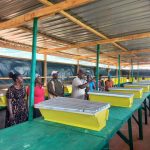Lets talk ” Kenyan Wildlife”
True leaders do not make choices by deferring to the opinion of the majority. They make choices based on the opinion of the truth; and the truth can come from either the majority or the minority! #KenyanWildlife needs your support @NAssemblyKE @Senate_KE more than ever before.
The wildlife conservation family has been left crumbling as other organisations shine. When on earth have we seen Government of Kenya members living in mud houses or driving old vehicles with worn tires? Come to wildlife family you will see them.
My campaign dubbed “Ivory Belongs to Elephants” has been in existence for the last 8 years, I have mingled with all the wildlife sectors, notably our key organisation KWS. This organisation is under-funded yet expected to execute conservation mandates in this country. I now stand a victim of advocating for the elephants/ wildlife conservation globally, and my only organisation is in a bad state. This has made all wildlife conservation look bad: we have lost habitats, conflict is on the rise, people are frustrated, people continue dying, and wildlife continue dying as we watch. So, where is the problem? No one will protect what they don’t care about, and no one will care about what they have never experienced. When personal agendas become more important than the team and the mission’s objective, performance suffers, and failure ensues. I remember one day our President urged all Kenyans to challenge their members of Parliament and Senators. I call upon Kenyans of good will let us charge our leaders to support wildlife conservation.
There is no single time KWS ever received their intended operational optimum budget; instead, its slashed by 70% by Parliament! Their actual budget is 9 billion annually, but they only get approximately 2.9 to 3 billion. How are they expected to execute their mandates? A carpenter cannot work without tools! In 2014 the Parliament passed the Wildlife Bill into law. The strong pillar of this Bill is to compensate the loss of wildlife. Thank you to those who released some amounts of money towards compensation. In fact, the CS of Tourism and the previous one has worked very hard to convince the Parliament to release funds. While they got a shoestring compensation, that was a mitigative measure. What is causing the conflict needs to be addressed and mitigated instead. The problem is clear: conflict is a result of land use changes and irresponsible development into critical wildlife areas. Several wildlife organisations have come together with measurable plans on how to mitigate conflict, but their plans need validation and enforcement by the national government.
In Amboseli for example, a group of environmental & conservationist came up with the “Amboseli Ecosystem Plan” geared towards reducing human- wildlife conflict, increasing wildlife habitats, as well as expanding community livelihoods. This plan, despite spending huge amounts of money, lacks implementation of good will. We have lost migratory, dispersal areas and instead we have “survival of the fittest” in the ecosystem and this replicates in other areas in Kenya. The “fittest” being the ones with money and power. Many Kenyans have asked the same questions I am asking and are labelled “enemies of people”! Do parliamentarians care for our wildlife?? Remember these are Kenyan wildlife! In 2015 there was a plan to declare a donated land in Laikipia as a National Park! What happened? KWS never got any support and instead the land was never released. It stands now unused.
Do you know that in the entire Laikipia- Samburu area there is no National Park? That ecosystem hosts the 2rd largest wildlife population in Kenya. There exists a KWS Station and post in Malaral and Rumuruti with adequate resources. The underlying questions is where do the wildlife live? Whose pastures do they eat? Who collects the revenue, if any, and who benefits?! Some conservationists came up with plans to help communities establish conservancies and they are doing well. However, what is their future? Most of them are established on the basis of conservation tourism benefits. Very expensive ecotourism facilities have been built, but most of these facilities cannot sustain themselves due to high risk and tourism market challenges! How difficult is it to have, at least, a national park in the ecosystem that can serve as a wildlife recharge? What is the future of this arrangement? Kenyans can remember popular conservancies/ high end lodges called Siana in Mara, Shompole in Magadi, Illingwesi in Laikipia, and Koija Star Beds in Laikipia. In the mid 2000’s these were the gems of Kenya. How many exist now? What happened, and has it been corrected? The answer is “no”.The issue is lack of government enforcement and support. The projects lacked the sustainability and right governance, coupled by political interferences.These are just but a few we have others such as Mwalungaje in Shimba Hills, Lumo in Taita and Kimana in Amboseli. They all died of the same disease.Good leaders don’t make excuses. They find a way to get it done.
Alluta continua.
Jim Justus Nyamu- Ivory Belongs to Elephants Campaign Walk




